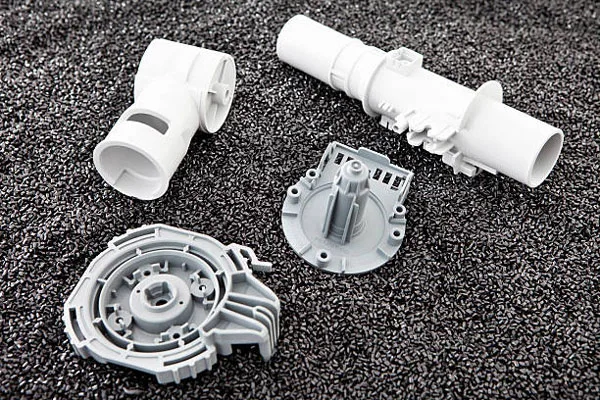Plastic injection molding stands as a highly efficient and cost-effective manufacturing solution capable of producing both simple and complex plastic components. This versatile process has gained widespread adoption across multiple industries due to its exceptional scalability, making it ideal for mass production of precision parts with consistent quality.
The technology’s ability to fabricate high volumes of identical components with tight tolerances has made it indispensable in sectors ranging from automotive and medical devices to consumer electronics and packaging. By injecting molten plastic into precision-crafted molds under controlled conditions, manufacturers can achieve complex geometries, detailed features, and superior surface finishes—all while maintaining cost-effectiveness for large-scale production runs.
What is Plastic Injection Molding?
Plastic injection molding is a manufacturing process in which molten plastic is injected into a mold cavity under high pressure. Once cooled and solidified, the part is ejected, resulting in a finished plastic component.
How Does Injection Molding Work?
The injection molding process consists of several key stages:
- Clamping: The two halves of the mold are securely clamped together under high pressure.
- Injection: Plastic pellets are fed into a heated barrel, melted, and injected into the mold cavity under high pressure.
- Cooling: The molten plastic cools and solidifies into the desired shape.
- Ejection: The mold opens, and ejector pins push the finished part out.
- Repeat: The cycle repeats for mass production.
Types of Injection Molding
Several variations of injection molding cater to different needs:
Thermoplastic injection molding-
This is the most widely used method for shaping plastics, using thermoplastic materials. Unlike thermosets, thermoplastics can be melted and hardened multiple times.
The process involves heating the plastic until it becomes liquid, injecting it into a mold and then cooling it to solidify. It is ideal for producing a wide range of components, from tiny electronic components to large automotive parts.
Insert Molding –
This method involves placing pre-made components, called inserts, into the mold before injecting the molten plastic. These inserts, typically made of metal or other materials, become embedded within the finished product. It is commonly used to add features such as metal threads or electrical contacts to molded parts.
Overmolding –
It involves shaping a material over a previously molded component.
This process allows the incorporation of different materials with varying properties, such as the addition of a soft-touch grip to a hard plastic handle.
It is often used for aesthetic enhancement or functional improvement.
Micro Molding –
It is a specialized technique used to produce very small, highly precise plastic components with tight tolerances. The process is crucial for industries such as electronics, medical devices and micro-optics. Due to the tiny scale involved, it demands specialized machinery and molds designed specifically for manufacturing miniature parts.
Gas-Assisted Molding –
This process involves using nitrogen gas to push out molten plastic from the mold cavity. The gas forms hollow areas inside the parts, which helps reduce material consumption, lower weight, and shorten cycle times. It is particularly effective for manufacturing large, hollow components with intricate shapes.

Plastic parts and materials
Advantages of Plastic Injection Molding:
- High Efficiency – Capable of mass-producing identical parts quickly.
- Precision & Complexity – Can create intricate geometries with tight tolerances.
- Material Variety – Works with thermoplastics, thermosets, and elastomers.
- Low Labor Costs – Highly automated, reducing manual labor requirements.
- Minimal Waste – Excess plastic can often be recycled.
Materials Used in Plastic Injection Molding
Common thermoplastics include:
- ABS (durable, impact-resistant)
- Polypropylene (PP) (flexible, chemical-resistant)
- Polyethylene (PE) (lightweight, used in packaging)
- Polycarbonate (PC) (transparent, high-strength)
- Nylon (PA) (wear-resistant, high-temperature tolerance)
Common Defects and Solutions
|
Defect |
Possible Cause |
Solution |
| Flash | Excessive injection pressure Reduce pressure | improve clamping |
| Sink Marks | Uneven cooling or thick walls Adjust cooling | uniform thickness |
| Warping | Non-uniform cooling | Optimize cooling channels |
| Short Shots | Insufficient material or pressure | Increase injection speed/pressure |
| Burn Marks | Overheating or trapped air Lower temperature | improve venting |
Applications of Injection Molding
Automotive – Dashboards, bumpers, interior trims.
Medical – Syringes, surgical tools, IV components.
Consumer Goods – Toys, containers, household items.
Electronics – Phone cases, connectors, housings.
Packaging – Bottle caps, closures, thin-walled containers.
Future Trends in Injection Molding
- Sustainable Materials – Bioplastics, recycled resins
- Industry 4.0 Integration – IoT sensors for real-time monitoring
- 3D-Printed Molds – Faster prototyping with additive manufacturing
- AI Optimization – Predictive maintenance, defect detection
